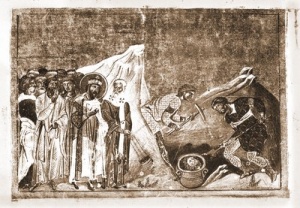DECOLLATION OF ST. JOHN THE BAPTIST
 |
Caravaggio painted this altarpiece while on the island of Malta. It was created for the
St John's Cathedral in the capital Valletta. Salome had ordered the Baptist's head, and in a few moments, she will receive it from the executioner. Her maid looks on in awe. The jailer tells the executioner to put the head on the charger. Two prisoners watch the scene.
The group on the left forms an arch, with Salome and the executioner bending to the floor. This is the only painting Caravaggio signed - in the blood of the Baptist.
|
Today is the feast day of the decollation (beheading) of St. John the Baptist. He was the last prophet of the Old Testament; also the greatest since he actually beheld the Saviour with his own eyes, while all the other prophets only pointed toward Him. John was purified in his mother's womb at the salutation of our Blessed Mother when she visited St. Elizabeth, who was carrying the Baptist. He was the precursor of Christ; he pointed Him out at the river Jordan. He then baptized Him at His request. Anyway, this is the day he was beheaded by Herod at the request of Salome, the daughter of Herodias, his brother's wife. Since it had been told to him by the Baptist that he could NOT have his brother's wife, a plot was schemed to kill the Baptist. Salome danced for Herod and pleased him and filled him with lust. (He probably wanted the daughter after this dance) Herod told her to ask for anything and he would get it for her. She asked for the head of John the Baptist. This dismayed Herod, but he had it done.
John had said concerning Christ: "He must increase and I must decrease." Thus the feast of the Decollation of St. John may be considered as one of the landmarks of the liturgical year. With the Greeks it is a holy day of obligation. (It doesn't even get an honorable mention in the western Church anymore). This Feast's great antiquity in the Latin Church is evidenced by the mention made of it in the martyrology called St. Jerome's, and by the place it occupies in the Gelasian and Gregorian sacramentaries. The precursor's blessed death took place about the feast Pasch; but, that it might be more freely celebrated, this day was chosen, whereon his sacred head was discovered at Emesa.
The vengeance of God fell heavily upon Herod Antipas. Josephus (a Jewish historian, who I believe converted), relates how he was overcome by the Arabian Aretas, whose daughter he had repudiated in order to follow his wicked passions; and the Jews attributed the defeat to the murder of St. John. He was deposed by Rome from his tetrarchate, and banished to Lyons in Gaul(France), where the ambitious Herodias shared his disgrace. As to her dancing daughter Salome, there is a tradition gathered from ancient authors, that, having gone out one winter day to dance upon a frozen river, she fell through into the water; the ice, immediately closing round her neck, cut off her head, which bounded upon the surface, thus continuing for some moments the dance of death.
Talk about Divine Justice! (I hope it's true; it seems so appropriate)!
St. John the Baptist, please pray for unrepentant sinners, especially those in our own families.
Relics
The First Uncovering of the Head of St. John the Baptist took place in the fourth century at the time when Saint Constantine the Great and his mother, St. Helen, began restoring the holy places of Jerusalem.
The Second Finding of the Precious Head of St. John the Baptist of took place on on February 18, 452, at Emesa.
After the Seventh Ecumenical Council (787), which reestablished the veneration of icons, the head of St. John the Baptist was returned to the Byzantine capital in around the year 850. The Church commemorates this event on May 25/June 7 as the Third Finding of the Precious Head of St. John the Baptist.
His relics are kept in several places including:
- St. Demetrios Church, Neo Phaleron, Piraeus
- Benaki Museum, Athens
- Sacred Relics Room, Topkapi Museum, Constantinople (entire right arm and cranium)
- Umayyad Mosque in Damascus, Syria
- Cetinje Monastery, Montenegro (right palm)
None of the sources gives an exact date, which was probably in the years 28-29 AD (Matthew 14:1-12; Mark 6:14-27; Luke 9:9) after imprisoning John the Baptist in 27 AD (Matthew 4:12; Mark 1:14) at the behest of Herodias his brother's wife whom he took as his mistress. (Matthew 14:3-5; Mark 6:17-20); According to Josephus, the death took place at the fortress of Machaerus.
 |
| A 1742 Tarì coin of the Knights Hospitaller, depicting the head of Saint John the Baptist on a silver round platter. |

No comments:
Post a Comment